Learning about dahlia care is a great first step for beginners who want to grow these showy, colorful blooms in their gardens.
With a little practice, the right amount of sun, water, soil, and attention, anybody can grow dahlias.
In this guide I will walk you through everything you need to know to successfully care for dahlias throughout the entire year.

Dahlia Quick Care Overview
| Scientific name: | Dahlia |
| Classification: | Tropical plant |
| Common names: | Dahlia |
| Hardiness: | Zones 8-11 |
| Temperature: | 60-85°F (15.5-29.4°C) |
| Flowers: | Red, pink, yellow, white, black, purple, orange, blooms mid-summer through fall. |
| Light: | Full sun |
| Water: | Keep evenly moist, do not overwater |
| Humidity: | Average |
| Fertilizer: | Low nitrogen fertilizer, summer-early fall |
| Soil: | Fertile, rich, well-draining |
| Common pests: | Snails, slugs, earwigs, aphids, beetles |
Information About Dahlias
Dahlias are a tender herbaceous perennial of the Asteraceae, or Daisy, family, and originally from Mexico and Central America.
They’re best known for the beautiful single-stem flowers that bloom from summer through fall.
The rest of the plant has bushy, leafy green foliage that grows from underground tubers. The heights and sizes range just as much as the blossoms.
Flowers can be anywhere from 2” all the way up to the huge dinner plate hybrids that can get up to 15” across, while plants range from low-lying ground cover to 5’ tall or more.
Different Types Of Dahlias
There are thousands of varieties to choose from, each featuring different heights, flower sizes, and colors.
No matter which you choose, the same general dahlia care is needed for them all. Here are some of the most popular ones.
- Cafe Au Lait – This decorative type has 6-8” sized blooms in a pale pink-peach color with tubular petals.
- Platinum Blonde – Pale yellow 4” anemone-style flowers feature wide petals on the outside and pom-pom like clusters of dense petals in the center.
- Labyrinth – The 7” flowers feature blended hues of peach, apricot, and pink on a decorative style flower that forms a star-like shape with pointed petals.
- Happy Butterfly – The upward facing petals on the waterlily-style 4” flowers start yellow on the outside with pink streaks and a deep fuschia center.
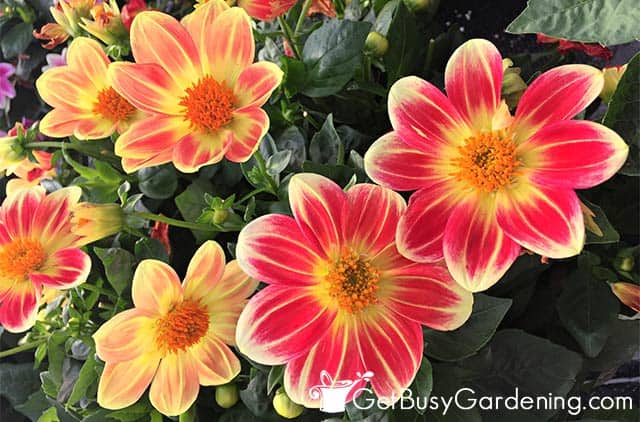
Flowers
The showy, gorgeous blooms are the main reason gardeners love to grow dahlias. They typically bloom early to mid-summer and last until the first frost in fall.
They’re unscented but, depending on the shape, can be attractive to pollinators. Colors range from pale pastels, like yellow, pink, and peach, to vibrant reds, purples, and even near-black.
The flowers are categorized by the arrangement and shape of the petals. Pompon, Ball, Waterlily, Cactus, Decorative, Single, and Anemone are some of the most popular types.
Toxicity
According to the ASPCA website, dahlias are mildly toxic to cats, dogs, and horses if ingested.
If you’re concerned about that, then it’s best to keep this plant away from your pets, if possible.
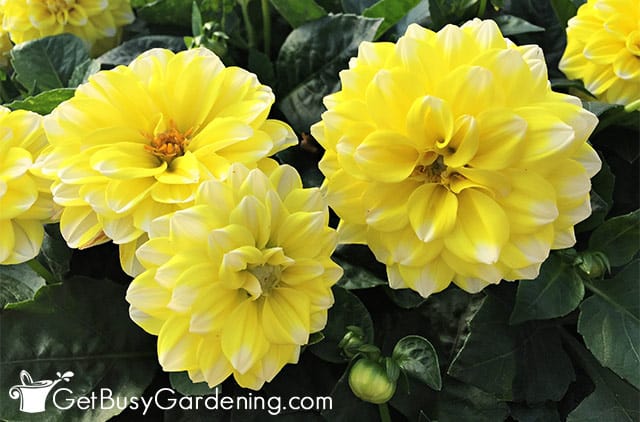
How To Grow Dahlias
Before we talk about dahlia plant care, first we need to discuss when and where to grow them. The perfect timing and location are key to encouraging blooms.
Hardiness
Dahlias are not cold hardy, and grow best in warm weather. They’re perennials, but only in zones 8-11 where the ground doesn’t freeze.
Everywhere else they’re annuals or you’ll need to bring them indoors for winter. Anything below 32°F (0°C) will damage, and eventually kill the entire plant.
Where To Grow Dahlias
The best place to grow dahlias is somewhere with direct sun and fertile soil. The spot should also be protected from the wind, which can knock down or break tall, heavy flower stems.
The low-growing varieties make nice ground covers or border plants, while the medium-sized ones are great for containers.
A 12×12 pot that’s deep and has good drainage works well for them, and you can move it inside more readily if you need to.
Tall varieties need space in the garden and may require staking to remain upright during blooming.
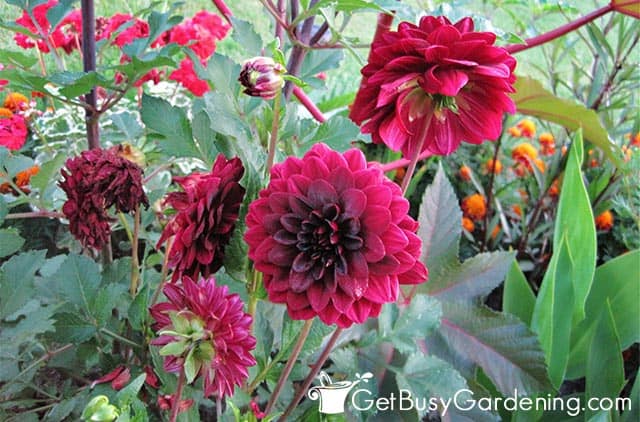
Dahlia Care & Growing Instructions
Now that you have the perfect place in mind, let’s talk about how to care for dahlias. The tips here will help you grow them to their full potential.
Light
Full sun for 6-8 hours a day is ideal for dahlias. If they get too much shade, it can stunt their growth, and they won’t bloom as profusely.
They prefer morning and evening sun over the harsher afternoon exposure, which can dry or sunburn the petals, especially in arid climates.
If that starts happening with yours, you can use a shade cloth to protect them from the intense afternoon rays.
Water
Proper watering is a crucial part of successful dahlia care. They like to stay evenly and consistently moist once they’re established, but too much will cause the roots and tubers to rot.
Wait to start until your dahlia has put on its first few leaves, then water deeply without making the soil soggy. Let it dry out slightly before giving it more.
If you struggle with the proper balance, a moisture gauge is an inexpensive tool that can help you get it just right.
Humidity
Dahlias like average humidity levels. Too much can cause mold and rot, while too little can wilt and dry them out.
If you live in a very humid climate, make sure to plant them in a spot where they will get good airflow, and don’t overcrowd them.
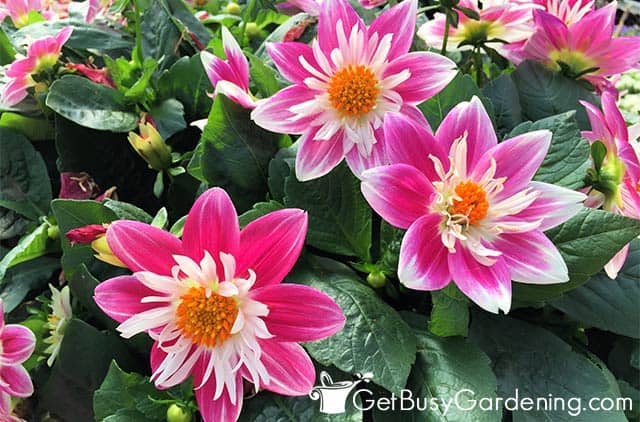
Temperature
Since dahlias hate the cold, the ideal temperature range to grow them is between 60-85°F (15.5-29.4°C).
Cooler temperatures will stop growth, while anything under 32°F (0°C) will kill the leaves and eventually the whole plant.
Excess heat of 90°F (32.2°C) or more can also stop blooming or damage existing flowers with sunburn and dehydration.
Fertilizer
As long as the soil is rich with nutrients, you won’t need to worry too much about fertilizing as a regular part of your dahlia care routine.
But the occasional feeding can help boost growth and increase the amount of blossoms.
After flowering has started, begin feeding with an all-natural organic option, like fish emulsion, compost tea, or a flowering fertilizer liquid.
Or, if you prefer, you could top-dress with flowering fertilizer granules. Apply liquids once every month, and granules every 6-8 weeks.
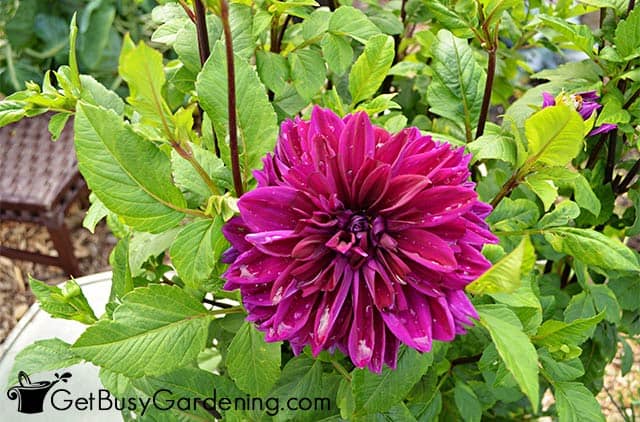
Soil
Dahlias aren’t too picky about their soil, but they thrive best in a fertile, rich, well-draining mixture.
If your garden has heavy clay or is very sandy, amend it with well-rotted manure or compost before planting.
In containers, use a high quality potting mix, and consider adding perlite or pumice to improve drainage.
Transplanting & Repotting
The best time to transplant or repot your dahlia is at the beginning of the growing season while the tubers are dormant.
Transplant them in early spring when it’s consistently above 60°F (15.5°C) outside. I like to soak the tubers in a compost tea solution overnight to help break their dormancy faster.
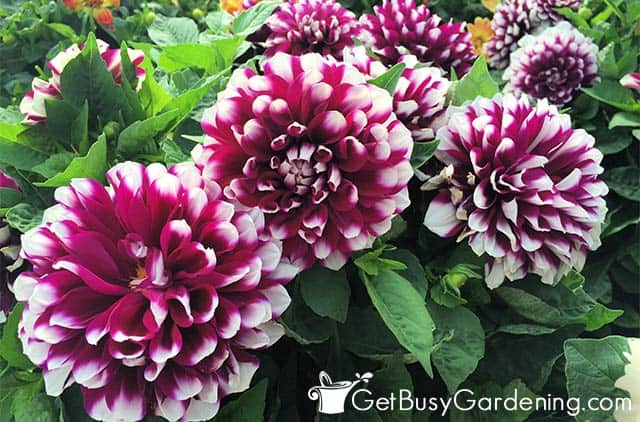
Pruning
Pruning throughout the growing season is an important part of dahlia care. It encourages more blooms and bushier foliage.
Once the main, central stem has reached 1’ in height, snip it back using clean sterile pair of pruners. Cut off 2-4”, or trim it back to the highest set of leaves to encourage branching.
You should also deadhead the spent or dying flowers regularly throughout the summer as they fade to stimulate more blooms.
Pest Control Tips
Common garden pests like slugs, snails, earwigs, aphids, and beetles can become issues on your dahlias.
For small insects, apply a neem oil spray or try using insecticidal soap to manage the spread. You can make your own by mixing 1 teaspoon of gentle liquid soap with 1 liter of water.
Use organic pellets or bait to keep slugs and snails at bay, and regularly clean up pest-harboring plant debris. You can hand-pick larger bugs and drop them into a bucket of soapy water.
Dormancy
Dahlias can bloom year round in warm enough climates. But once it freezes outside, the foliage will die back, and the tuber will go dormant.
In zones 8-11, you can simply cut them down to the ground and add some dry mulch on top for warmth. In other areas, wherever the ground freezes, you must dig them up or they won’t survive.
Check out my guide on how to overwinter dahlias indoors for detailed help, but the basics are simple.
Dig up the tuber carefully to avoid nicking or damaging it, and leave it somewhere sunny to cure (dry).
Then bring it inside, pack it in peat moss or coco coir, and store it in a cool, dry location that’s between 50-60°F (10-15.5°C) until spring.
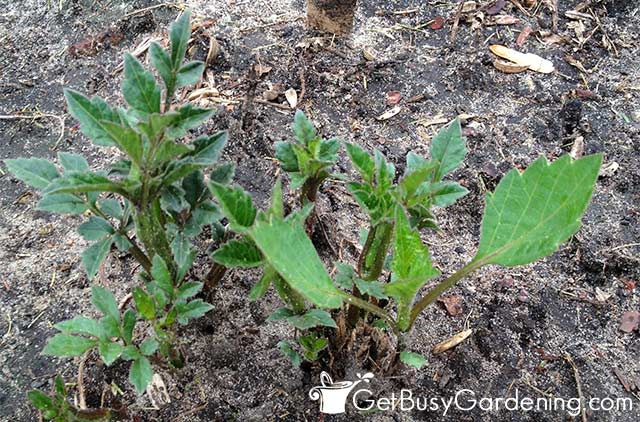
Dahlia Propagation Tips
You can propagate your dahlias from seed, stem cuttings, or by dividing them. Seeds usually produce a different flower than the parent, so most gardeners use cuttings or divisions.
It’s best to split them before planting in the spring. Separate the tubers by hand or with a clean, sharp knife, and ensure that each piece has a pink eye, which is where the stems will sprout.
Place them somewhere sunny in slightly damp, fertile soil, and keep them very lightly moist until they’re rooted and start putting on new growth.
Troubleshooting Common Problems
Though dahlias are pretty easy to care for, there is no such thing as a plant with zero problems.
If you run into one of these more common ones, my tips below can help you troubleshoot the issue and get it back on track.
White Spots On Leaves
White spots on the leaves is usually a sign of powdery mildew. It’s caused by excess humidity or from moisture sitting on the leaves after watering. The best way to treat it is with an organic fungicide.
Prevention is also key, make sure there is good airflow between plants, and avoid watering overhead where the moisture can collect on the leaves and flowers.
No Flowers
There are a couple of reasons why your dahlias aren’t flowering, but a few simple care adjustments will get them blooming again.
Lack of sun, overwatering, too much fertilizer, or temperature fluctuations are all potential causes.
Plant or place them somewhere with at least 6 hours of direct sun. Keep the soil moist, but avoid making it puddled or overly wet.
Fertilizer can be helpful, but high doses or too much nitrogen will deter blooming. If the soil is nutrient-rich, then there’s no need to feed them.
Yellow Leaves
Some of the most common reasons for yellowing leaves on dahlia plants is lack of nutrients, too much shade, improper watering, pests, or rot.
Over or under watering can each cause problems. Too much can lead to rot and dying foliage, while long periods of drought will dehydrate them.
Also, check for pests and treat any you see right away. If that’s not the issue, consider a dose of low-nitrogen fertilizer, and make sure they’re in full sun.
Leaves Turning Brown
Browning foliage can also be caused by too much or too little water, lack of light, poor nutrition, insect damage, sunburn, or rot.
Use a moisture gauge to help measure water, keep them somewhere sunny in good soil, and check for pests.
Hot afternoon sunlight or frost can also brown or blacken the foliage, so keep an eye on the location and temperature if everything else looks fine.
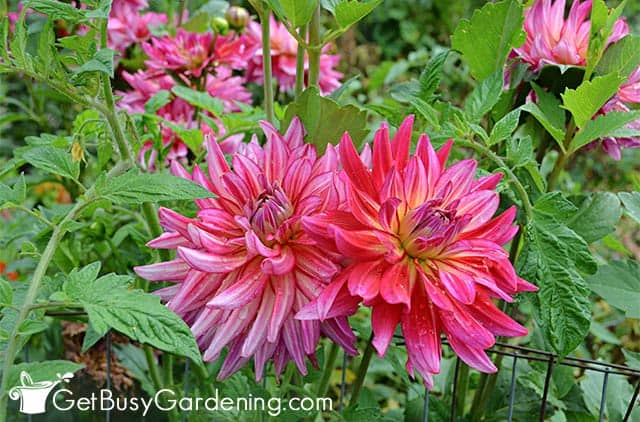
FAQs
Here I’ve answered some of the most commonly asked questions about dahlia plant care. If yours isn’t listed, please add it to the comments section below.
Are dahlias easy to grow?
Dahlias are easy to grow once you master the basics of their care needs. They need plenty of sun, rich soil, consistent water, and regular pruning to keeping them thriving and blooming their best.
Where do dahlia flowers grow best?
Dahlia flowers grow best in a full sun location with regular, even moisture, and rich, fast-draining soil in an area that’s sheltered from wind.
Is a dahlia plant an annual or perennial?
A dahlia plant is a perennial in zones 8-11 where it can survive outdoors year round, but it’s commonly grown as an annual in colder climates.
What is the secret to growing dahlias?
The secret to growing dahlias is to master their ideal environment, and know when to plant them. Wait until the ground is 60°F (15.5°C) or above, then plant them in full sun and well-draining fertile soil.
Why are dahlias so hard to grow?
Dahlias can be considered hard to grow by beginners who don’t know how to care for them properly. With plenty of sun, rich soil, consistent watering, and regular pruning anyone can easily grow them.
If you want to learn all there is to know about maintaining healthy indoor plants, then you need my Houseplant Care eBook. It will show you everything you need to know about how to keep every plant in your home thriving. Download your copy now!
More About Flower Gardening
- How To Care For Caladiums
- How To Grow Canna Lilies
- How To Grow Zinnias
- How To Care For Castor Bean Plant (Ricinus communis)
- How To Care For Ornamental Sweet Potato Vine
Share your dahlia care tips in the comments section below.
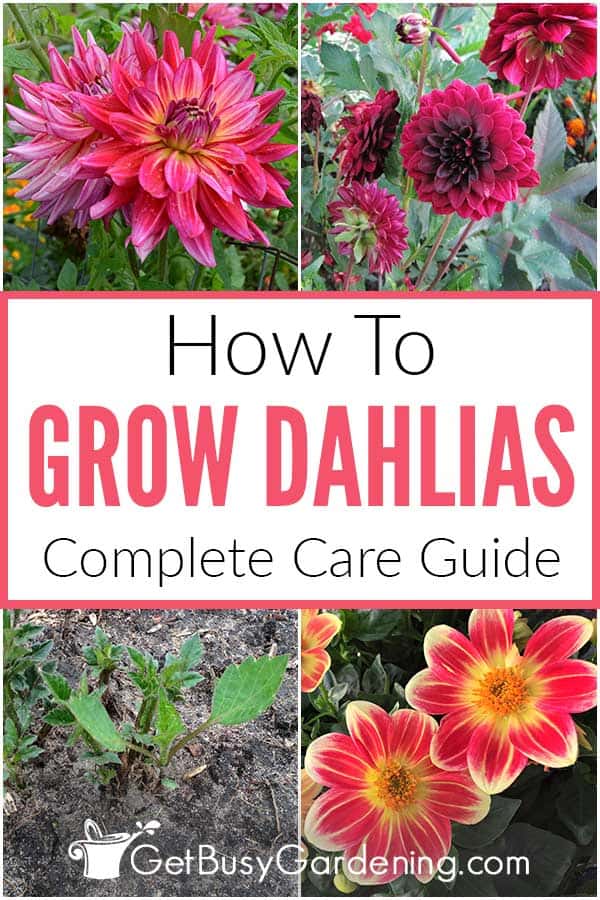
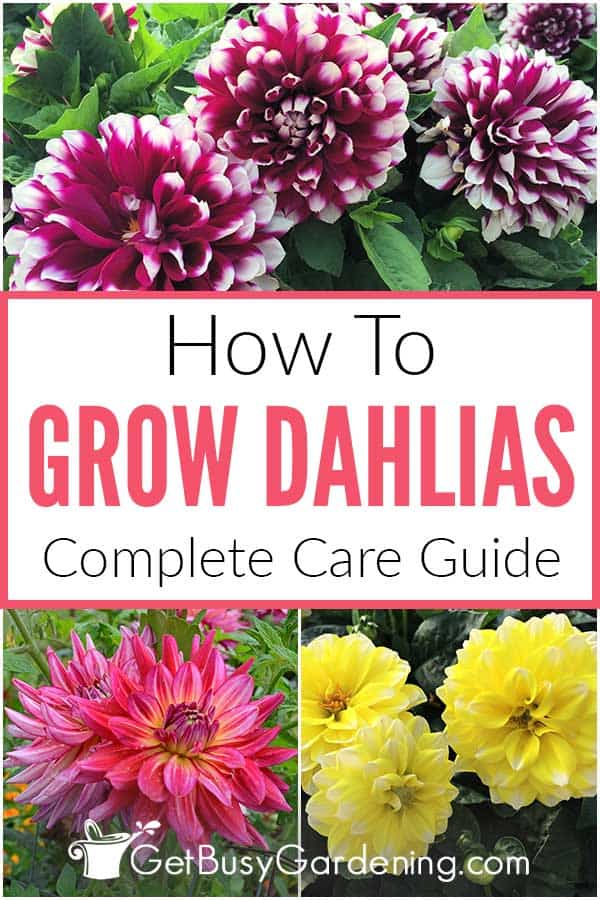
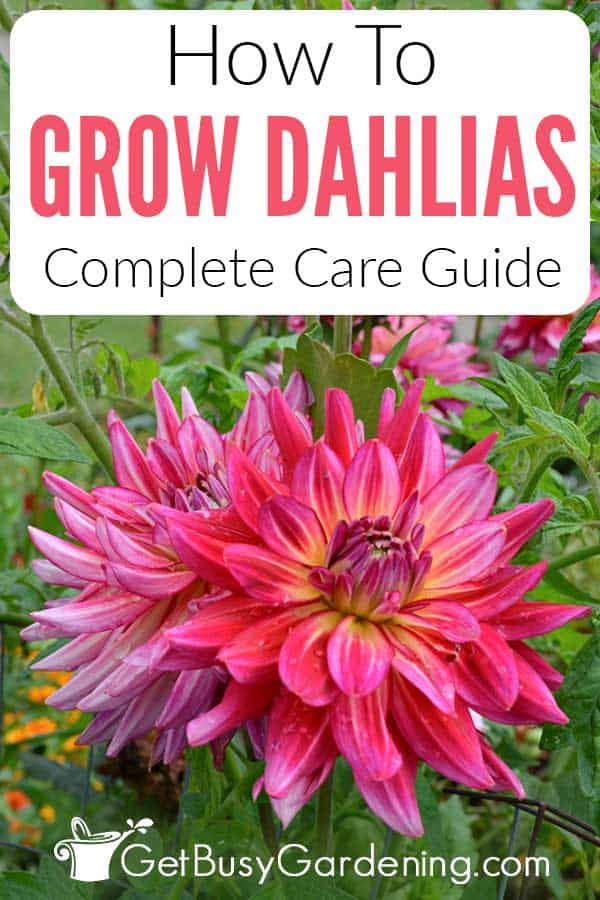




Leave a Reply